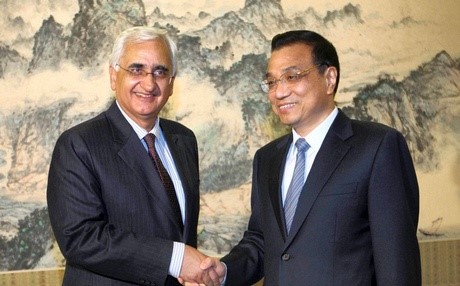 Amid the incursion of 19.5 km in the Daulat Beg Oldi sector of the Depsang Valley in Ladakh by the PLA; Indian Foreign Minister; Salman Khurshid visited Beijing. This was followed by Li Keqiang’s three day visit to India. Although the two visits were scheduled much in advance they drew attention as they took place soon after the border incursion.
Amid the incursion of 19.5 km in the Daulat Beg Oldi sector of the Depsang Valley in Ladakh by the PLA; Indian Foreign Minister; Salman Khurshid visited Beijing. This was followed by Li Keqiang’s three day visit to India. Although the two visits were scheduled much in advance they drew attention as they took place soon after the border incursion.
The entire complex state of affairs begs a few questions; what did India and China achieve out of the respective visits? What did the two visits achieve in terms of the border dispute?
Highlights of the Visit: Who Gets What?
Salman Khurshid visited China with a delegation comprising of thirty-five members of the Association of Industries MP (AIMP). One of the main agreements signed during the visit was a new protocol to enhance cooperation between the foreign ministers to step up coordination for providing timely information to the media. It was an upgradation of a similar protocol signed in 2006 in which the two countries listed various new dialogues that have come up between the two countries.
Li Keqiang arrived in India with an economic agenda; he stated ‘the purpose of my current visit to India is threefold- to increase mutual trust, to intensify cooperation and to face the future’. Eight agreements/MoUs were signed during his visit along with a thirty-five paragraph joint statement.
Emphasising the economics of the bilateral relation; the Strategic Economic Dialogue was discussed which eventually led to the first meeting of the India –China CEO’s Forum http://www.ipcs.org/pdf_file/issue/IB184-Teshu-IndiaChina.pdf.
The recommendation of the forum would be used to enhance bilateral trade and investment. ‘Co-operation on pharmaceutical supervision including regulations, stronger links between Chinese entrepreneurs and the Indian IT industry and completion of phytosanitary negotiations on agro products’ were offered by the Chinese. The willingness to provide platform for cluster- type development of enterprise of the two countries were also articulated.
Further, to promote trade, personnel movement and connectivity across the border, the two sides agreed to consider strengthening border trade through Nathu La Pass http://www.ipcs.org/pdf_file/issue/IB204-CRP-Teshu-NathuLa.pdf.The achievements of Bangladesh, China, India and Myanmar (BCIM) additionally, the economic corridor connecting India, Myanmar and ASEAN countries was discussed.
Starting from paragraph 20-35, the joint statement mentions political and international issues. Both sides also agreed to further strengthen cooperation in the areas of energy and environmental conservation, new and renewable energy and high-technology. The commitment to promote multilateral arms control, disarmament and non proliferation processes was done. Emphasis on the maritime security and non-traditional security threats were discussed. Two major developments on the globe; Afghanistan and the Asia Pacific were also highlighted. Other important global issues of convergence like the cooperation in the United Nation, UNSC, Doha Development Round of WTO, energy and food security, reforms of the international financial institution and global governance were agreed.
Major Road Blocks
Trade and the border dispute remained the major highlights of the visit. With a target of USD 100 billion trade by 2015, the two countries agreed to take measures to address the issue of the trade imbalance. The bilateral trade has been highly in China’s favour and trade deficit with China totalled to USD 29 billion in 2012. While India's exports to China were only USD13.52 billion in 2012-13, its imports from that country aggregated to USD 54.3 billion, leaving a trade deficit of USD 40.78 billion. Apart from the aforementioned economic engagement there was no assurance for greater access for Indian goods in Chinese market.
Undoubtedly, the border dispute was one of the major highlights during both the visits. Reasons for the intrusion were not discussed neither there was any assurance for a demarcation of the LAC. The joint statement merely mentioned ‘Pending the resolution of the boundary question, the two sides shall work together to maintain peace and tranquility in the border areas in line with the previous agreements’. Special Representatives on border issues started meeting in 2003 and a bilateral working mechanism for consultation and coordination was set up in 2012. Till now fifteen rounds of talks have been held. In fact the visit was a great opportunity to discuss the boundary issue but nothing new was achieved in terms of boundary issue. Perhaps this was an opportunity missed by the two sides and still the unresolved question remains as a major irritant in bilateral relations.
Overall it was a ritualistic visit and had very little to offer in terms of the future trajectory of India –China relationships. The developments of the two visits will be followed during Manmohan Singh’s visit sometime this year to China.
Courtesy : Institute of Peace and Conflict Studies (http://www.ipcs.org)